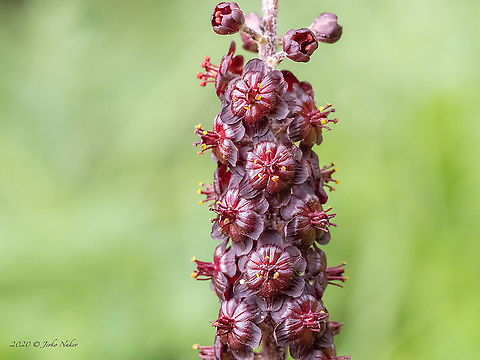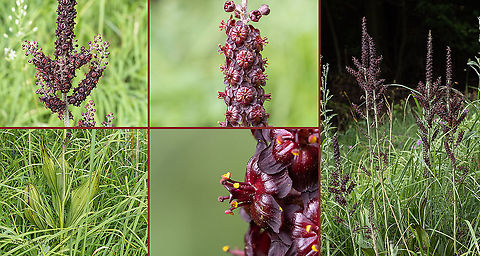
Appearance
The plant has a robust black rhizome. Simple angiosperm leaves arranged in a whorled pattern emerge from the base of the plant. Each whorl is decussate , with only two or three whorls around the base. Each leaf is sessile , and about 12 inches in length. The leaves are broad, glabrous , lanceolate in shape, with entire edges. The veins in the leaves branch immediately from the base and run parallel through the leaf, leaving a pleated look. Long, green, coarse, woody spike racemes branch off in decussate patterns from the main trunk, with short pedicels supporting a single flower. The flowers are purple-black, giving the plant its name.''Veratrum nigrum'' blooms in early summer for several weeks, but goes dormant in intense summer heat. It tends to grow in colonies, and attains a height of about 4 feet . Its racemes branch out to about 24 inches in width. The seed heads are crimson in color. Plants grown from seeds will generally push through the earth and sprout leaves in early spring.

Distribution
''Veratrum nigrum'' is native to Eurasia from France to Korea including Germany, Poland, Russia, China, and Mongolia. The plant can exist in hardiness zones 4 through 7. It grows best in shade or partial shade, with wet or moist grounds conditions. Any nutrient-rich soil supports its growth, although one source observes that it prefers calcium-rich soil. Another source observes that the bed must be fairly deep.Defense
All parts of the plant are highly toxic. However, the highest concentrations of toxins tend to be in the rhizome. Toxicity varies widely depending on the method of preparation, and the method of application. Just 1.8 grams per 1 kilogram can cause death due to cardiac arrhythmia. Death has even occurred at a dosage as low as 0.6 grams.''Veratrum nigrum'' contains more than 200 steroid-derived alkaloids, including isorubijervine, jervine, pseudojervine, rubijervine, tienmuliumine, tienmuliluminine, and verazine. The herb causes irritation of mucous membranes. When ingested, the irritation of the mucosal membranes of the stomach and intestines will cause nausea and vomiting. If the herb is introduced to the nose, this mucosal irritation will cause sneezing and coughing. Ingestion can also cause bradycardia , hyperactivity, and hypotension . In high concentrations, topical contact can cause skin irritation, excessive tears from the eyes, and redness.
Classic symptoms of ''Veratrum nigrum'' toxicity include blurred vision, confusion, headache, lightheadedness, nausea, stomach pain, excessive sweating, and vomiting. In severe cases, heart arrhythmia, muscle cramps, extreme muscle twitching, paresthesia , seizures, weakness, and unconsciousness occur. Death may follow.
Toxic symptoms generally resolve themselves after 24 to 48 hours. Supportive treatment for the symptoms is usually administered. Because extreme vomiting occurs, decontamination is usually not implemented unless ingestion has occurred within one hour. Atropine is usually administered to counteract the low heart rate, and sympathomimetic drugs and liquids administered to raise the blood pressure.
The herb is also a known teratogen. However, no data exists on whether it can cause birth defects in human beings.
Uses
In Asia, an extract of the herb is mixed with water in a 1 percent to 5 percent solution and used in many rural areas to kill fleas, their larvae, and their eggs in toilets.References:
Some text fragments are auto parsed from Wikipedia.